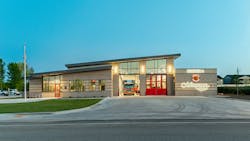A Michigan fire chief recently shared with me the floor plans for his new fire station. Before his next review, the chief asked for my thoughts. After emphasizing I was not an architect, I reviewed the plans and shared what I have learned from previous station design conferences. He pointed out that as a volunteer department, they were looking to the future and adding space for career personnel in the next few years.
At previous conferences, architects have often spoken of designing new fire stations “…to last 50 to 75 years.” It is very possible with modern design elements, building materials and trends in durable interior products, that these facilities will stand that long.
But who can predict what will be needed for a fire station in 50 to 75 years? Can you predict what your department’s responsibilities or personnel requirements will be even 10 or 20 years from now?
Going through old copies of fire magazines proved fire departments and stations have changed significantly over time. In 1987, one of the topics at the International Association of Fire Chiefs conference was “Safety: The Next Megatrend in the Fire Service,” a topic that has certainly taken hold over the last 30 years.
Reviewing 20 years of entries to the fire station design awards, we found significant changes in station design: Twenty years ago, an article in a fire magazine supported the use of vehicle exhaust-removal systems in all apparatus bays in fire stations. A variety of in-station training opportunities were designed in response to increased responsibilities and budget restrictions of departments, and to save costs of firefighters traveling to regional training facilities.
As the number of women in the fire service increased, separate bathrooms were added to new and existing fire stations. These bathrooms have evolved into individual unisex restrooms and showers.
Just over ten years ago, volunteer fire departments facing fewer volunteers were encouraged to include sleeping areas for future transition to full-time personnel. Pro-active, the Houston Fire Department created a virtual reality room in its training facility that delivered “…simultaneous, synchronized media content, view and sound to multiple kiosks or training station.” Virtual training in departments is on the increase.
We also saw an increased installation of fire sprinklers in fire stations; the security and separation from the public became a priority for safety of department personnel; and reminders the Americans with Disabilities Act (ADA) is required and applicable to fire stations, including elevators to below grade or second floors. Removal of turnout gear from apparatus bays and the addition of separate ventilation in turnout gear rooms.
Perhaps the most significant change to fire stations was in 2014 with the introduction of the Hot Zone design. As research on cancer in firefighters continues to expand, the Hot Zone design divides fire stations into three zones—red, yellow and green—to raise awareness of the need to decontaminate, transition and offer a safe place after exposures on a response.
So how can you predict what your department will even need in a fire station 10-15 years from now?
Technology advances? The 2004 Tokyo Fire Department conference featured five fire department robots. The robots included a reconnaissance robot, a remote-controlled firefighting robot, an underwater robot, and a robot that can climb exteriors of buildings. U.S. fire departments have started using drones and a couple metro departments have robots for bomb detection. What’s in your future?
Safety? Obviously, the reduction of cancer-causing carcinogens, but the recent pandemic has demanded new protocols, protective gear, and decontamination areas. Civil unrest in several areas—both urban and suburban—requires increased review of facilities ability to withstand attack. Escalating incidents of natural disasters will involve storage for emergency supplies.
We’ve already seen the spiked demand for emergency medical services, so, coupled with communities’ requirements for fire sprinklers and prevention, could your fire station eventually have more ambulances than fire apparatus? Will the “fire stations” become “emergency response facilities”?
Obviously, we can’t even fathom how the responsibilities of fire and EMS will evolve five years from now, let alone 20, 30 or 50 years out. Adaptable space is probably the best we could suggest. Perhaps at the next Station Design Conference the presentations will include looking forward, so your fire station isn’t out of date or outgrown in the next decade or two.
About the Author
Janet A. Wilmoth
Special Projects Director
Janet Wilmoth grew up in a family of firefighters in a suburb of Chicago. Wilmoth, who is owner of Wilmoth Associates, worked with Fire Chief magazine for 27 years until it closed in 2013. She currently is the project director for Firehouse, overseeing the Station Design Conference.

